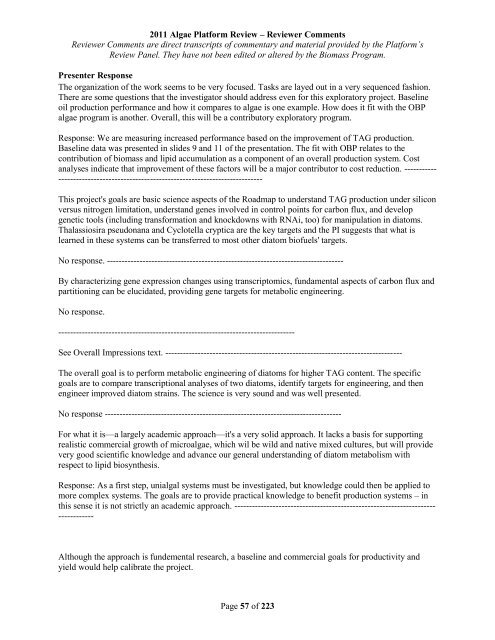Reviewer Comments - EERE
Reviewer Comments - EERE
Reviewer Comments - EERE
You also want an ePaper? Increase the reach of your titles
YUMPU automatically turns print PDFs into web optimized ePapers that Google loves.
2011 Algae Platform Review – <strong>Reviewer</strong> <strong>Comments</strong><br />
<strong>Reviewer</strong> <strong>Comments</strong> are direct transcripts of commentary and material provided by the Platform’s<br />
Review Panel. They have not been edited or altered by the Biomass Program.<br />
Presenter Response<br />
The organization of the work seems to be very focused. Tasks are layed out in a very sequenced fashion.<br />
There are some questions that the investigator should address even for this exploratory project. Baseline<br />
oil production performance and how it compares to algae is one example. How does it fit with the OBP<br />
algae program is another. Overall, this will be a contributory exploratory program.<br />
Response: We are measuring increased performance based on the improvement of TAG production.<br />
Baseline data was presented in slides 9 and 11 of the presentation. The fit with OBP relates to the<br />
contribution of biomass and lipid accumulation as a component of an overall production system. Cost<br />
analyses indicate that improvement of these factors will be a major contributor to cost reduction. -----------<br />
---------------------------------------------------------------------<br />
This project's goals are basic science aspects of the Roadmap to understand TAG production under silicon<br />
versus nitrogen limitation, understand genes involved in control points for carbon flux, and develop<br />
genetic tools (including transformation and knockdowns with RNAi, too) for manipulation in diatoms.<br />
Thalassiosira pseudonana and Cyclotella cryptica are the key targets and the PI suggests that what is<br />
learned in these systems can be transferred to most other diatom biofuels' targets.<br />
No response. --------------------------------------------------------------------------------<br />
By characterizing gene expression changes using transcriptomics, fundamental aspects of carbon flux and<br />
partitioning can be elucidated, providing gene targets for metabolic engineering.<br />
No response.<br />
--------------------------------------------------------------------------------<br />
See Overall Impressions text. --------------------------------------------------------------------------------<br />
The overall goal is to perform metabolic engineering of diatoms for higher TAG content. The specific<br />
goals are to compare transcriptional analyses of two diatoms, identify targets for engineering, and then<br />
engineer improved diatom strains. The science is very sound and was well presented.<br />
No response --------------------------------------------------------------------------------<br />
For what it is—a largely academic approach—it's a very solid approach. It lacks a basis for supporting<br />
realistic commercial growth of microalgae, which wil be wild and native mixed cultures, but will provide<br />
very good scientific knowledge and advance our general understanding of diatom metabolism with<br />
respect to lipid biosynthesis.<br />
Response: As a first step, unialgal systems must be investigated, but knowledge could then be applied to<br />
more complex systems. The goals are to provide practical knowledge to benefit production systems – in<br />
this sense it is not strictly an academic approach. --------------------------------------------------------------------<br />
------------<br />
Although the approach is fundemental research, a baseline and commercial goals for productivity and<br />
yield would help calibrate the project.<br />
Page 57 of 223




